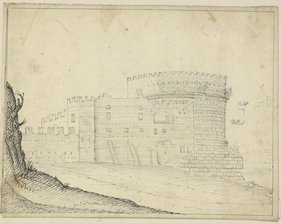When, at the beginning of 1787, the painter Johann Heinrich Wilhelm Tischbein chose the tomb of Cecilia Metella on the Via Appia Antica as the central motif for the background of his famous oil painting "Goethe in der Campagna", a number of artists had already made intensive studies of this ancient Roman funerary monument erected in the first half of the 1st century BC. Among the documentation by travellers from German-speaking countries, the sheet presented here is one of the oldest known examples. The draughtsman, who has not yet been identified, has noted the date of origin of the sketch at the bottom of the sheet: "den 6 tag December 1637. Rom". The tomb was considered a popular object of study, especially because of its good state of preservation and the precise workmanship of the frieze, and it received particular appreciation through Giovanni Battista Piranesi's series of engravings in the Antichità romane, which was published for the first time in 1756. The draughtsman of this sheet also captured the profile and a detail of the frieze in small sketches on the right-hand edge of the picture. However, he only insufficiently succeeded in the spatial representation of the cylindrical structure.
Regardless of this, however, the viewpoint the draughtsman chose is worth mentioning. In contrast to the more popular view from the west and north sides of the building with the Gaetani castle complex added at the beginning of the 14th century, he chose a location from which he could capture the building from the east side. He was obviously attracted by the compositional structure of the picture, which resulted from the gradual ascent of the walls of the castle towards the structure of the mausoleum and the sloping hillside at this point.
In addition to ancient architecture, the draughtsman also showed an interest in contemporary architecture: on the other side of the sheet he captured - in what is probably one of the earliest known depictions - the church of San Giovanni dei Fiorentini in Rome. This church, begun in 1520 according to plans by Antonio da Sangallo the Younger, was not completed until 1614 by Carlo Maderno (except for the façade) because of several interruptions.
Not least because of its format, the sheet with the double-sided sketches can be identified as an original part of a travel sketchbook. The identification of the draughtsman, on the other hand, is difficult. With regard to journeys to Italy by German-speaking artists, especially in the third decade of the 17th century, the sources are scanty, even though two important protagonists of the German-speaking reception of Italy, Martin Zeiller and Hieronymus Welsch, were travelling in this decade in the midst of the Thirty Years' War. Due to the circumstances of these warlike years, an artist or master builder from the Tyrolean or Bavarian regions would be the most likely candidate.
sp

